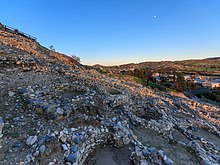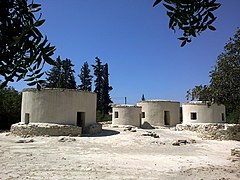Chirokitia
Coordinates: 34 ° 47 '48.2 " N , 33 ° 20' 37.4" E
Chirokitia ( Greek Χοιροκοιτία ( f. Sg. ), Trans. Also Khirokitia ) is an archaeological excavation site on the Mediterranean island of Cyprus in the Larnaka district . The excavation site has been part of the UNESCO World Heritage Site since 1998 .
location
The excavation is north of the highway midway from Larnaka to Limassol .
Digs
Khirokitia has been excavated since 1934 under the direction of Porfyrios Dikeos and a French expedition under Alain Le Brun , but so far only partially. Several round huts (one with a house burial) and part of the defensive wall were reconstructed on the site.
Dating
The settlement is one of the Aceramic Neolithic . It was made from the 7th to the 4th millennium BC. Inhabited and had an estimated 300-1000 inhabitants.
Economy and house building
The population lived from livestock and agriculture (including wheat and barley). The ground plans of the surrounding wall and of around 60 round houses with graves under the floor have been preserved. Some houses have been reconstructed. Most of the archaeological finds are kept in the Cyprus Museum in Nicosia . The dead were buried in a crouched position under the houses.
- Chirokitia
meaning
In the meantime, Shillourokambos and Tenta Chirokitia, which are more than 1000 years older, have become the oldest settlement in Cyprus. However, the settlement is still considered to be one of the most important prehistoric sites in the Eastern Mediterranean.
From an archaeozoological point of view, the excavation site is of considerable importance because it is here that domesticated cats outside their African place of origin can be detected for the first time. They were made in Chirokitia in the 7th millennium BC. First introduced as pets and used to hunt rodents. The early farmers had brought these with them involuntarily. The oldest find dates from the 8th millennium, namely from Sillourokambos. These are descendants of Felix silvestris lybica , from which all domestic cats descend.
literature
- Alain Le Brun, Fouilles récentes à Khirokitia (Chypre), 1977–1981 (Paris, Editions Recherche sur les civilizations 1984)
- Alain Le Brun, Fouilles récentes à Khirokitia (Chypre), 1983–1986 (Paris 1989)
- Alain Le Brun, Fouilles récentes à Khirokitia (Chypre), 1988–1991 (Paris 1994)
- P. Dikaios, Khirokitia: final report on the excavation of a neolithic settlement in Cyprus on behalf of the Department of Antiquities, 1936-1946. Monographs of the Department of Antiquities of the Government of Cyprus 1. Published for the Government of Cyprus by Oxford University Press 1953.
Web links
- Evaluation of UNESCO (English and French; PDF file; 1.1 MB)
- Choirokoitia on the Cypriot Government Web Sites
Remarks
- ↑ Nicole Reynaud Savioz : Des chats et des hommes. Histoire du chat domestique (Felis catus) en Valais, racontée par l'archéozoologie , in: Caroline Brunetti, Alain Dubois, Olivier Paccolat, Sophie Providoli (eds.): Alexandra Antonini. Hommage à une archéologue médiéviste , Sion 2019, pp. 467–480, here: p. 468.






